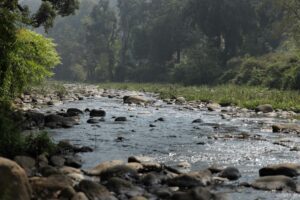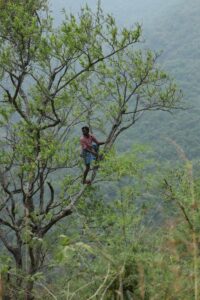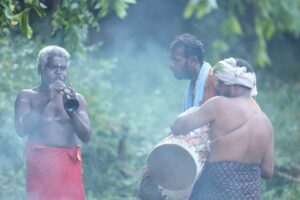K Devabalan's documentary captures the efforts of the district administration to accord Community Forest Rights to indigenous settlements.

Devabalan's documentary was exclusively screened at the Urban Climate Film Festival (UCFF) in Chennai. (Supplied)
Nestled deep within Coimbatore’s lush and verdant forest range, amid indigenous tribal settlements, a profound philosophy takes root: “The land is our revered deity and the forest is our way of life.”
This declaration sets the tone for a 13-minute documentary on Community Forest Rights (CFR), directed by K Devabalan of Bright Ray Productions.
Recently, the documentary was exclusively screened at the Urban Climate Film Festival (UCFF) in Chennai.
As the documentary unfolds, it weaves captivating visuals with poignant anecdotes from settlement residents of Pillur and Palamalai.
“While relying on natural resources in the wild for their livelihoods, they also protect them. In return, the forest generously bestows its bounty,” shares Deva, who received the Tamil Nadu State Tourism Award 2022 for his Kaani documentary series.

The documentary offers viewers a panoramic perspective of the Western Ghats. (Supplied)
While the documentary offers viewers a panoramic perspective of the Western Ghats, the heart revolves around the achievement of CFR status for 35 tribal settlements in the Pillur and Palamalai clusters.
“This has been a milestone achievement for the District Administration,” shares K Booma, former Revenue Divisional Officer for Coimbatore North, who mooted the idea of a GPS tracking survey to accord CFR status — a first in the state.
The initiative was spearheaded by former Coimbatore collector GS Sameeran. “Without his visionary initiative, this wouldn’t have been possible,” says Booma, recalling the year-long process that bore fruit in November 2022.
“The collaboration of all departments, including the Forest Department, NGOs, and especially those from the settlements who volunteered to learn GPS tracking and map their traditional collection points and other sites, made this process comprehensive. It was a fulfilling experience,” she tells South First.
In the documentary, Deva, along with a 13-member crew, captures the remarkable strides achieved through the allocation of CFR.
This includes endowing tribal communities with the right to access, collect, and sell minor forest resources; the right of way to temples and traditional burial grounds inside the forest, among other things.
This achievement, realised years after the promulgation of the Forest Rights Act in 2006, extends against breathtaking visuals.

The Irulars engaged in gooseberry collection. (Supplied)
The journey of producing the documentary, Deva tells, was an immersive 20-odd days of exploration.
“We delved deep into the communities’ resource-gathering practices. This journey beautifully opened us to the connection the indigenous people share with the forest and its hidden treasures,” he explains.
Each step in this process unveiled new learnings to the crew.
“From traditional honey harvesting points and evocative rituals, to the locations that house tall gooseberry trees, which only the Irulas can adeptly climb and pluck from — they guided us everywhere, as if we were one of their own. I am glad we had the opportunity to document this. It was a demanding yet profoundly satisfying experience,” he shares.
GS Sameeran, in the documentary, highlights how 350 hectares of land were surveyed by involving volunteers from the tribal clusters.
Here, the collaborative efforts of NGOs like the Keystone Foundation, World Wildlife Fund (WWF), and Adi Federation too played pivotal roles.
Deva and his team meticulously capture this process.
However, the crew too had to overcome formidable challenges — from navigating dense forests to filming amid untamed wildlife, which required patience and meticulous planning.
Starting work as early as 4:30 am became imperative to authentically capture the rituals unfolding in the tribes’ lives with clockwork precision.
“Challenging terrains, unpredictable weather, and restricted accessibility too presented its own set of obstacles. We even had a close encounter with a tusker. But the people from the settlements and the administration ensured our safety,” shares Deva.
With every shot, the viewer is transported into a world where reverence for the natural world becomes a way of life.
Furthermore, a delicate balance emerges between ancient traditions and how the tribes have embraced modern technology, such as GPS tracking, to secure their rights.
The closing shots of the documentary feature visuals of tribes dancing around a bonfire to the traditional music of Irulars.

Each step in this process unveiled their way of life to the crew. (Supplied)
“When we captured this moment, they danced with their entire hearts. However, it wasn’t for the sake of the film; rather, it was their hearts expressing the language of joy. It was truly a sight to behold,” Deva fondly reminisces.
The journey of these tribal communities, tied intimately to their land and forests, mirrors the enduring human pursuit for autonomy and a balanced coexistence with nature.
“These newly acquired rights have granted us genuine liberation. It’s a celebration of independence,” affirms a community member in the documentary.
Just days after the country marked its 77th Independence Day, these sentiments echo a genuine sense of liberty.
Cinematographer: Navin Kumar
Editor and sound designer: Ponnuvel Damodaran
Voiceover scriptwriter: CH Rajkumar
Associate director: G Aravindan
Colourist: Sreeram Balakrishnan
Drone operator: Vinoth KumarConformist: Manikandan
Stills: Nirmal Vijay
Subtitles: Nandish
Audio engineer: Rasool
Voiceover artist: TS Ranganathan
CG: Amarnath
Data management team: Parthipan
Assistant DOP: Pavithran KV and Edisonraj S
Camera operators: Rexon, Kannan, Saravanan
Production executive: Seenivasan
To watch more of the team’s work, visit Instagram @BrightRayProductions

Jul 21, 2024

Jul 15, 2024

Jul 15, 2024

Jul 14, 2024

Jul 11, 2024

Jul 10, 2024